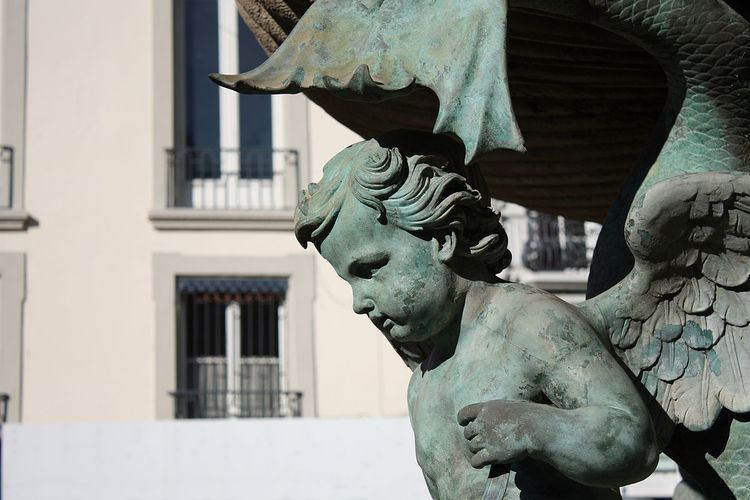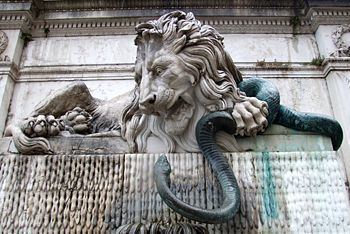Name Victor Sappey | Died March 23, 1856 | |
 | ||
La Fontaine des Éléphants Chambéry
The French sculptor Victor Sappey was born in Grenoble in Isère on 11 February 1801 and died on 23 March 1856. He was also known as Pierre-Victor Sappey. His father was a stonemason.
Contents
- La Fontaine des lphants Chambry
- Biography
- Work entitled Le Drac
- The fountain des dauphins
- The fountain of Le serpent et le dragon
- The statue of General Jean tienne Vachier Championnet Valence Drme
- The Fontaine des lphants in Chambry
- The Fontaine de la nymphe or fountain Hygie Uriage les Bains
- Alexandre Michal Ladichre
- Tombstones in Voreppe cemetery
- Self Portrait
- Benjamin Rolland
- Flix Ral
- Jacques de Vaucanson
- LEnfant au poisson La Pche
- LIsre
- Medallion entitled La Justice
- La Mort de Lucrce
- Le Gant des Alpes
- Louis Joseph Vicat
- Paul Marie Edouard Dupuy de Bordes
- Thodore Ravanat
- Monument to J M Vagnat
- Monument to General Marchand
- Monument to Mrs Recoura
- Other work
- References

Biography
Sappey worked in the workshop of Rogge in Paris in 1824. He lived for two years in Egypt with his friend Jean Achard, a famous painter from Dauphiné, and a group of St. Simonians. He was professor then director of the École des Beaux-Arts de Grenoble.
He was also one of the first sculptors to use cement as a sculptural material, with for example the statue of "Génie des Alpes" in Uriage-les-Bains, Isère. This was destroyed, but the model is still kept at the Musée dauphinois.
He was a friend of Théodore Ravanat and Henri Fantin-Latour, and was close to all members of the École dauphinoise that he attended in Proveysieux. He was the father-in-law of the Grenoble sculptor Aimé Charles Irvoy (1824–1898).
Work entitled "Le Drac"
This work In terra cotta was executed in 1833 and is held by the musée de Grenoble, who purchased it in 1856. The Drac is a major French river in the region.
The fountain des dauphins
This fountain is in Grenoble and is also known as the "Château d'eau" or "Fontaine des dauphins".
The fountain was erected as a tribute to the Marquis de Lavalette who was a mayor of Grenoble and created many public fountains in the city. Nadon was the sculptor of the complete fountain with Sappey creating the four winged angels riding dauphins. See photograph.
The fountain of "Le serpent et le dragon"
Over many years Grenoble had suffered from severe flooding (see Grenoble flood 1859).
This fountain, completed in 1843, is located near the Saint-Laurent bridge in Grenoble. In Sappey's composition the lion symbolizes the city of Grenoble defeating the Isère river which is represented by a snake. Sappey was inspired by the violent encounter of the two rivers, the Drac and Isère, which often burst their banks causing flooding and devastation in the Grenoble area. The lion is carved from stone whilst the snake is in bronze.
The statue of General Jean Étienne Vachier Championnet, Valence, Drôme
Jean Étienne Vachier Championnet had been born in Valence in 1762. The monument, comprising a bronze statue by Sappey on a pedestal, was inaugurated 24 September 1848
The "Fontaine des éléphants" in Chambéry
This monument was erected in 1838 in honour of General de Boigne who had been a generous donor to the town of Chambéry. It celebrates de Boigne's achievements in India.
The "Fontaine des éléphants" comprises a pedestal and fountain, a column and a statue. Four elephants, only their front legs head and trunks being visible, appear to emerge from the four sides of the pedestal and there are four bas-reliefs at the very top of this pedestal, these depicting scenes from de Boigne's life in India. Then around the top of the pedestal, Sappey carves various mementos of Indian life. From the pedestal a tall column emerges and on top of that column is a statue of de Boigne himself. The monument was inaugurated on 10 December 1838. Water runs down from the elephant's trunks into the fountain's basins.
The "Fontaine de la nymphe" or fountain Hygie, Uriage les Bains
Uriage les Bains is a spa town, with thermal springs, and Sappey's composition for the town's fountain is a depiction of the Goddess Hygie.
Alexandre Michal-Ladichère
In 1836, Sappey completed a plaster medallion depicting Alexandre Michal-Ladichère. It is held in the musée de Grenoble.
Tombstones in Voreppe cemetery
In Voreppe cemetery Sappey was responsible for the tombstones of Amable Rome and his son. Rome was a doctor who was immortalized by Balzac.
Self-Portrait
The musée de Grenoble have in their collection a terra cotta relief self-portrait.
Benjamin Rolland
The musée de Grenoble also have in their collection an 1830 bronze medallion depicting Benjamin Rolland.
Félix Réal
A plaster bust of Félix Réal is also held in the musée de Grenoble.
Jacques de Vaucanson
A plaster bust of Jacques de Vaucanson by Sappey is held in the musée de Grenoble.
"L'Enfant au poisson ; La Pêche"
This work in marble dating to 1849 is held by the musée de Grenoble.
"L'Isère"
This 1835 statuette in terra cotta is in the musée de Grenoble collection.
Medallion entitled "La Justice"
This medallion refers to the tribunal in Bois. Held by the musée de Grenoble
"La Mort de Lucrèce"
This 1828 high-relief in plaster is held by the musée de Grenoble.
Le Géant des Alpes
This statue reached a height of 5 metres and was made from cement. It was destroyed but a model is held in the Musée dauphinois in Grenoble.
Louis-Joseph Vicat
This 1855 bust is in the musée de Grenoble collection.
Paul-Marie-Edouard Dupuy de Bordes
Bust of Paul-Marie-Edouard Dupuy de Bordes as a child and in marble dates to 1843 and held by musée de Grenoble
Théodore Ravanat
1836 plaster medallion held in musée de Grenoble collection.
Monument to J. M. Vagnat
Sappey was the sculptor of this monument in the Saint Roch cemetery in Grenoble.
Monument to General Marchand
In 1851 Sappey sculpted the tombstone of General Marchand also in Saint Roch.
Monument to Mrs Recoura
1855 tombstone work in marble in the Saint Roch cemetery.
Other work
Sappey was also famous for his caricatures.
